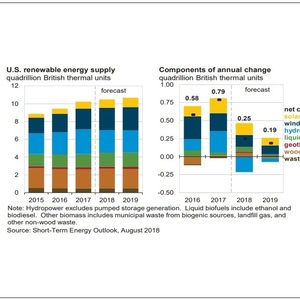EIA: Bioenergy capacity, generation to increase next year




U.S. Energy Information Administration
August 7, 2018
BY Erin Krueger
The U.S. Energy Information Administration has released the August edition of its Short-Term Energy Outlook, predicting that nonhydropower renewables will provide more than 10 percent of electricity generation this year, increasing to nearly 11 percent in 2019. In 2017, nonhyropower renewables provided slightly less than 10 percent of U.S. electricity production.
Wood biomass is expected to be used to generate 120,000 MWh per day of electricity this year and next year. Waste biomass is expected to be used to generate 58,000 MWh per day of electricity in 2018, increasing to 59,000 MWh per day next year.
The electric power sector is expected to generate 90,000 MWh per day of electricity this year, including 49,000 MWh per day from waste biomass and 42,000 MWh per day from wood biomass. Next year, the sector is expected to generate 92,000 MWh per day from biomass, including 50,000 MWh per day from waste biomass and 42,000 MWh per day from wood biomass.
Other sectors are expected to generate 87,000 MWh per day from biomass, including 78,000 MWh per day from waste biomass and 9,000 MWh per day from wood biomass in both 2018 and 2019.
Advertisement
The electric power sector is expected to consume 0.28 quadrillion Btu (quad) of waste biomass this year, increasing to 0.285 quad next year. The sector is also expected to consume 0.246 quad of wood biomass in 2018, increasing to 0.25 quad next year.
The industrial sector is expected to consume 0.17 quad of waste biomass this year, falling to 0.169 quad next year. The sector is also expected to consume 1.463 quad of wood biomass in 2018, falling to 1.42 quad next year.
The commercial sector is expected to consume 0.045 quad of waste biomass and 0.084 quad of wood biomass in both 2018 and 2019.
Advertisement
The residential sector is expected to consume 0.401 quad of wood biomass in 2018, increasing to 0.42 quad in 2019.
On a combined basis, all U.S. sectors are expected to consume 0.496 quad of waste biomass this year, increasing to 0.5 quad next year, along with 2.194 quad of wood biomass in 2018 falling to 2.174 quad in 2019.
The EIA currently predicts total biomass power capacity will reach 7,363 MW by the end of 2018, up from 7,313 at the end of 2017. By the close of 2019, biomass capacity is expected to reach 7,526 MW. Waste biomass capacity is expected to reach 4,284 MW at the end of this year, up from 4,234 MW at the end of 2017. By the end of next year, waste biomass capacity is expected to increase to 4,288 MW. Wood biomass capacity was 3,079 MW at the end of both 2017 and 2018, and is expected to increase to 3,238 MW by the close of next year.
Upcoming Events





